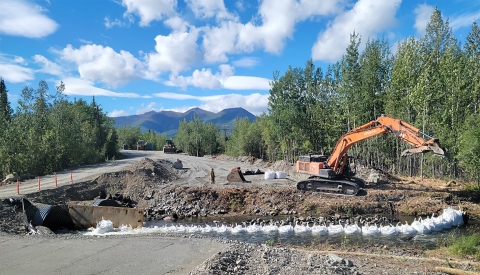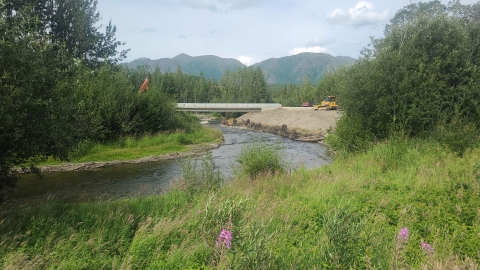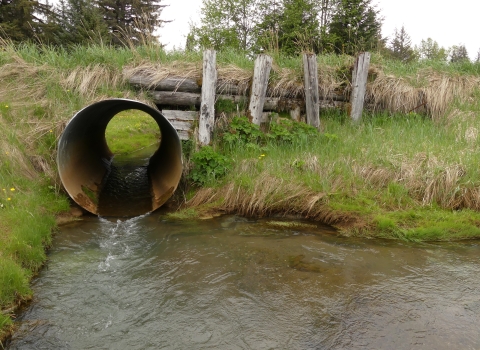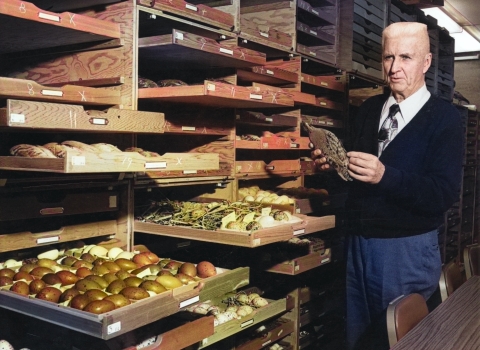Greek philosopher Heraclitus once said, “No man ever steps in the same river twice, for it's not the same river and he's not the same man.”
Alaska’s rivers are no exception. One day they’re a trickle, the next a torrent. Rivers carve up landscapes and jump their banks. They are collectors of rain, last winter’s snow, and ancient waters from glaciers warmed by the sun. They muscle boulders, fallen trees, and heavy loads of silt towards sea. And when they encounter culverts that don’t respect change, they blow right through and take roads with them too.
A road-stream crossing failing during high flows is a violent, forceful event. The culvert becomes a firehose and eventually clogs with debris the river plucked from its banks and floodplain. With nowhere to go, water overtops and saturates the road until the pressure mangles the corrugated metal and carries the road and everything therein downstream in a whoosh of turbid, angry water.
In 2006, this happened on the Little Tonsina River when it reached flood stage and overwhelmed an access road in Alaska’s Valdez-Cordova Borough— homelands to Ahtna people and an area that Sugpiaq and rural Alaskans depend on for access to hunting and fishing, wild food security, and cultural ties to the land. It’s also one of the major regional access points for the Trans Alaska Pipeline.
The ruined culverts that carried the Little Tonsina through the road prior to 2006 still rested downstream in its riverbed over 15 years later. Following the catastrophic road failure, an “emergency fix” of similar, undersized design was quickly applied where river met road as a necessary, short-term patch job to maintain crucial resource access. However, if we consider this temporary fix to be a permanent solution, those failed, rusty relics offer a preview of inevitable things to come.
The River
Fast forward to 2022 and you could get a sense for this river’s true potential while looking beyond the current undersized double culverts—gravelly, clean, and cold; perfect conditions for Coho and Chinook salmon. If you were to follow it downstream, you’d hit the Tonsina River proper—a class III-IV whitewater with excellent fishing for Pacific salmon, Dolly Varden, and Arctic Grayling. These waters eventually meet Alaska’s Copper River, home to what many people consider one of the world’s finest sources of Sockeye and King Salmon.
Standing on the road and looking upstream, the water is pooled, a common symptom of a fish passage fish passage
Fish passage is the ability of fish or other aquatic species to move freely throughout their life to find food, reproduce, and complete their natural migration cycles. Millions of barriers to fish passage across the country are fragmenting habitat and leading to species declines. The U.S. Fish and Wildlife Service's National Fish Passage Program is working to reconnect watersheds to benefit both wildlife and people.
Learn more about fish passage barrier created by an undersized road-stream crossing and the associated disruption of natural flow. Over 70 miles of glacier-fed salmon nursery habitats extends upstream to the horizon.
Breaking ground
Prior to 2022, the prospect of fitting the road with a bridge to accommodate the Little Tonsina and its varied flows was already attracting attention and funding from multiple state and federal partners—if the past is a preview of the future, the same culvert design is not expected to survive another 50-year flood event.
It takes many hands to build a bridge. The Chugach Alaska Corporation entered into a land transfer and right of way agreement that ultimately makes this work possible. Herculean partner funding efforts have raised several million dollars, including $1 million dollars from Alaska Department of Transportation and $1.3 million dollars in Bipartisan Infrastructure Law Bipartisan Infrastructure Law
The Bipartisan Infrastructure Law (BIL) is a once-in-a-generation investment in the nation’s infrastructure and economic competitiveness. We were directly appropriated $455 million over five years in BIL funds for programs related to the President’s America the Beautiful initiative.
Learn more about Bipartisan Infrastructure Law funding. The non-profit partner Copper River Watershed Project has kept communication going between partners and shepherded this project to construction phases. This collaboration and additional financial and technical support from many partners, will finally let the Little Tonsina flow free as it should and provide a reliable ribbon of access for hunters, anglers, and infrastructure maintenance in a sparsely-roaded area.
Initial groundbreaking activities in 2022 included clearing and grubbing, creating access lanes, building the platforms that will be the bridge embankments, and installing rootwads upstream for bank stability and fish habitat. The existing undersized culverts acted as coffer dams so in-channel construction (including in the riverbed and its banks) could take place "in the dry"—a plus for equipment operation—and water quality issues associated with construction can be minimized. And what of the old culverts downstream? They were plucked out in the fall of 2022 by the Alaska-based contractor, a woman-owned small business.
In August 2023, the two lane, 100-foot floodplain- and fish-friendly bridge was open for traffic. Designed to pass a 100-year flood, the new structure employs the U.S. Fish and Wildlife Service’s comprehensive Alaska design guidelines for building road-stream crossings that have fish and flood resiliency in mind.
For Fish, First and Foremost
As climate change climate change
Climate change includes both global warming driven by human-induced emissions of greenhouse gases and the resulting large-scale shifts in weather patterns. Though there have been previous periods of climatic change, since the mid-20th century humans have had an unprecedented impact on Earth's climate system and caused change on a global scale.
Learn more about climate change continues to disproportionately impact northern locales like Alaska, it’s ever important to provide salmon unimpeded access to all habitat options. Culverts and bridges designed with flows and fish in mind do this, keeping salmon runs resilient, fisheries stable, and roads reliable for local communities and economies.
The Little Tonsina has the distinct honor of being the first BIL-funded fish passage project to break ground in the USA. The project is one of 40 across the country that received funding in 2022 as part of the five-year $200 million commitment to removing in-stream barriers and providing technical assistance under the National Fish Passage Program. However, it follows on the coattails of millions of dollars already invested in fish-friendly roads across Alaska. Good work also tends to also catalyze funding and momentum to address additional barriers and unstable infrastructure at a watershed level or nearby tributaries: successful restoration at this site opens the door for an additional 21 anadromous crossing sites within the interior Copper River watershed totaling an additional 91 miles and over 1,500 lake acres of restored salmon habitat access.
Conservation is a team sport. In addition to our dedicated Copper River Watershed staff biologist, Fish Passage Engineer, and Engineer Tech, project partners include Chugach Alaska Corporation, Copper River Watershed Project, the State of Alaska, Bureau of Land Management, NOAA Fisheries, and The Denali Commission.
With increased flood intensities forecasted, our team of habitat restoration practitioners in the Southern Alaska Fish and Wildlife Field Office is committed to supporting ongoing fish passage efforts and fish-friendly infrastructure to keep fisheries healthy and communities connected in Alaska’s changing environment. Thanks to fish-friendly road standards being adopted at local level and major investments in fish passage statewide, a barrier-free Alaska is within reach.
In Alaska we are shared stewards of world renowned natural resources and our nation’s last true wild places. Our hope is that each generation has the opportunity to live with, live from, discover and enjoy the wildness of this awe-inspiring land and the people who love and depend on it.










